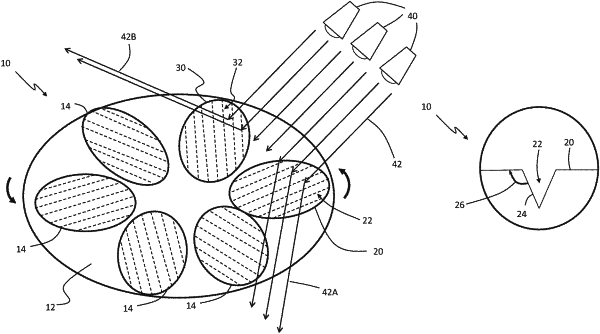| CPC F21V 7/048 (2013.01) [A44C 15/0015 (2013.01); F21V 7/0025 (2013.01); F21V 7/05 (2013.01); F21V 7/10 (2013.01); F21V 14/02 (2013.01); F21V 14/04 (2013.01); F21W 2121/06 (2013.01)] | 20 Claims |

|
1. A light reflection apparatus with grooved surfaces comprising:
a first surface of a reflective material having a plurality of parallel grooves arranged in a first groove pattern;
a second surface of the reflective material having a plurality of parallel grooves arranged in a second groove pattern, the first surface being distinct from the second surface such that an entirety of the first groove pattern is fully separate, non-overlapping, non-intersecting, and in a different location from an entirety of the second groove pattern, and wherein the plurality of grooves in the second surface having at least one of:
a different angular shape than the plurality of grooves in the first surface;
a different size than the plurality of grooves in the first surface;
a different angular orientation than the plurality of grooves in the first surface; or
a different unit density than the plurality of grooves in the first surface; and
at least one light source emitting light on the first and second surfaces, wherein the emitted light does not pass through the first and second surfaces, and wherein a quantity of reflected light is emitted from the first and second surfaces while an orientation between a path of the emitted light relative to the first and second surfaces changes by either moving the first and second surfaces relative to the at least one light source or by moving the at least one light source relative to the first and second surfaces, wherein the plurality of grooves in the first surface reflects the emitted light independently of the plurality of grooves in the second surface.
|